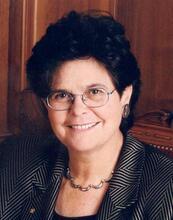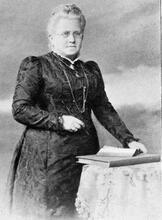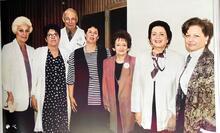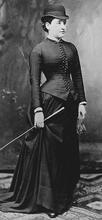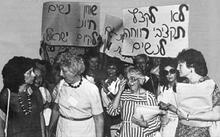Maimie Pinzer
May (Maimie) Pinzer was born in Philadelphia, Pennsylvania, in 1885 to Polish-Russian Jewish parents. Pinzer spent her adult life in many cities in the United States and Montreal, Canada. Her professional background was diverse: she worked as a prostitute, stenographer, and community worker, among many other jobs. In 1915, she established The Montreal Mission for Friendless Girls, a home and meeting space that welcomed former and current prostitutes. She documented her life in letters addressed to Fanny Quincy Howe, a member of the Boston economic and social elite. The two women maintained a correspondence for twelve years. Pinzer’s letters reveal the reality of working-class women at a time when not many authentic accounts by women like her existed.
Introduction
“I can handle girls due to having been one of them, and yet—I believe—am so far removed as to be able to command their respect,” wrote Maimie Pinzer, in 1915, about young women in sex work. A former prostitute herself, Pinzer ran The Montreal Mission for Friendless Girls to support current and former prostitutes in Montreal, Canada, from 1915 to 1917. Her relatability distinguished her from reformers and social workers of the time.
Pinzer’s life is recorded in letters she wrote to Fanny Quincy Howe from 1910 to 1922, published as a book, The Maimie Papers, in 1977, long after her death. Pinzer shared her challenging teenage years, her shifting personal relationships, her financial troubles, and her unwavering ambition. Her eloquent account of her professional career gives insight into the life of a working-class woman in 1910s United States and Canada.
Early Life and Prostitution
Maimie Pomerantz Jacobs, better known as Maimie Pinzer, was born in Philadelphia, Pennsylvania, on July 14, 1885. Her parents, Julia and Morris, were Polish-Russian Jewish immigrants. She had three brothers and one sister. Although her childhood was quite comfortable, her father’s murder in around 1898 when she was twelve or thirteen years old made her teenage years drastically more difficult. After her father’s death, the family could no longer afford housekeeping help. Her mother forced Pinzer to abandon her studies, which she loved, for housework to maintain the household of five children. Pinzer also began working at a department store and started dating men.
At the age of thirteen, Pinzer spent several nights at a man’s house, which prompted her mother to request her arrest—a grave response, perhaps reflective of their difficult mother-daughter relationship. When Pinzer was imprisoned at the police station in the Philadelphia City Hall, she exchanged sexual favors with a prison guard in order to be allowed out of her cell. At her judicial hearing the next morning, her mother and uncle, who had molested her throughout her childhood, accused her of being an incorrigible child. Pinzer was transferred to the Moyamensing Prison, then sent away to a Magdalen Home, a reform institution for girls, for a year. From this period onwards, she learned how to use prostitution to ensure her security.
Following her release from the Magdalen Home at around fourteen years old, Pinzer initially moved home before moving with a lover named Frank Sloan to Boston, Massachusetts, where they lived from 1899 to 1903. Facing many health challenges, she was treated in hospitals in New York City and Philadelphia in 1904 and 1905, possibly for sexually transmitted infections, and she had 31 surgeries related to the removal of her infected left eye. In search of economic stability, she married carpenter Albert Jones in 1906. Her marriage to Jones did not yield the security she had hoped for, due to his frequently precarious work status, and she turned to prostitution to supplement the couple’s income.
As a working-class woman, Pinzer’s methods for survival were limited to marriage, unskilled and low-paying labor like factory or domestic work, and prostitution. Pinzer first chose prostitution and marriage. She selectively and privately engaged with respectable and wealthy men, prompted by her economic circumstance. Concerned with class and status, Pinzer avoided any association with other prostitutes.
Correspondence with Fanny Quincy Howe
In 1909, Pinzer met social worker Herbert Welsh and began exchanging letters with him. In 1910, he moved her to Philadelphia, to be hospitalized for her morphine addiction. Welsh connected Pinzer to Fanny Quincy Howe, a member of the Boston economic and social elite. From this point forward, Pinzer committed to no longer using prostitution as a tool to make ends meet in extreme cases.
Pinzer and Howe exchanged letters between 1910 and 1922. The two women built a deep connection. In these letters, Pinzer often expressed her love and admiration for “Mrs. Howe.” She often asked Howe for advice on personal and professional dilemmas and hoped to gain approval for her actions. Howe frequently supported Pinzer financially. The women shared a mutual appreciation, despite their different social standings.
In 1911, Pinzer and Jones separated. Pinzer then spent periods living with Ira Benjamin, her childhood sweetheart, who was of Russian Jewish origin. Benjamin supported Pinzer when he could, although he also struggled to maintain financial stability. After her divorce became final, Pinzer and Benjamin married in 1917. Subsequently, the frequency of Pinzer’s letters to Howe subsided. She explained to Howe that instead of writing to her as she formerly did when she was worried, she could now share those worries with her husband. In the last letter Pinzer sent to Howe, in 1922, she still asked Howe for advice.
Career
Despite Pinzer’s difficulty finding steady work, her letters to Howe make her persistence and ambition evident. Pinzer was industrious in her pursuit of a better livelihood and unsatisfied with the existing options readily available to lower-class women. This type of work was especially unattractive to Pinzer because prostitution yielded comparatively high earnings. With her intelligence and ability to speak five languages (she likely learned Russian and Yiddish from her parents and French by living in Montreal, in addition to English and German), Pinzer aimed for a more advanced type of labor. Her pressing financial needs and responsibilities, however, often made her consider returning to prostitution. She notes these contemplations in early letters, although her actions were sometimes unclear.
In December 1911, Pinzer began to study stenography. She was enthusiastic about the pursuit of additional education and hoped this skill would present her with more professional opportunities. Pinzer had often been denied public-facing work because of the patch she wore over her eye. Both her missing eye and her gender remained barriers to professional success. In one bookkeeping position she took to supplement her income, she was assaulted by her male employer. However, Pinzer found stable employment as a stenographer and worked in a number of her firm’s offices in different cities. In 1913, she moved to the Montreal office. In 1914, she became interim manager. Shortly after this promotion, however, she left the firm, due to a conflict with the manager.
Pinzer then attempted to penetrate the business world independently by starting the Business Aid Bureau in Montreal in the winter of 1914 with Jean Holland, a university-educated Irish immigrant with reporting, advertising, and translation experience in Canada. Pinzer’s business savvy brought success despite the institutionalized sexism blocking women’s professional achievements, but the First World War negatively impacted business and Pinzer closed the Bureau after about a year of operation.
The Montreal Mission for Friendless Girls
Following the closure of the Business Aid Bureau, Pinzer shared an idea with Howe to create a common space to house girls in need and help them find work, to prevent them from engaging in prostitution. Pinzer had already begun caring for young women in an unofficial capacity.
Pinzer founded The Montreal Mission for Friendless Girls in 1915 with the support of benefactors. She operated the mission out of her apartment, where she could provide young women a place to gather, eat, sleep, and find guidance. Pinzer wanted to target English Protestant and Jewish women because they were excluded from the charity work administered by the Catholic Church. In Montreal, institutions and services were split by religion and language: Catholic organizations functioned in French and Protestant organizations functioned in English. Ashkenazi Jewish immigrants learned English and were often grouped with Protestants. Pinzer was opposed to using friendless in the name because of its negative connotation. In fact, she was against naming the mission altogether, wanting it to seem informal and open. Her personal, compassionate approach, informed by her own experience, differed greatly from the standard treatment of prostitutes by social workers and reformers at the time. She wanted the space she curated to be a haven for such young women. Unlike most reformers’ concentration on morality during the American Progressive Era’s intense campaign against prostitution, Pinzer was more concerned with providing material than spiritual help. Pinzer had to close the mission in the fall of 1917 when she moved out of the flat it operated out of, although she continued to aid young women afterward by meeting with and receiving telephone calls from them, since she could no longer host them or materially support them in a meaningful way.
Family
Pinzer had a strained relationship with her family. In 1911, she reconnected with her mother, to whom she had not spoken in eleven years. When she lived in Philadelphia in the 1910s, she worked at her brother James’ store and cared for his daughter, although he treated Pinzer poorly. She also cared for her sister, who was institutionalized in Norristown, Pennsylvania, and visited her every other week, sometimes reporting on her mental and physical health in letters to Howe. Pinzer often assumed financial responsibility and care duties for many members of her family.
Pinzer had the impression that her family never moved on from her past as a prostitute and felt like an outsider. Instead, her loved ones were Howe; her dog, Poke; Stella Phillips, a former prostitute whom she cared for and favored; and her second husband, Ira Benjamin. Pinzer suggested that her practice of certain Christian rituals further worsened her family’s opinion of her.
Jewish Identity and Religion
Upon social worker Welsh’s requests, Pinzer attended church every Sunday for many years and found a certain comfort in it. Nevertheless, she always saw herself as a Jew and celebrated Jewish holidays, noting rituals associated with Rosh Hashanah, Purim, and Shavuot in her letters; participated in Jewish cultural life, like attending a Jewish wedding, watching a Yiddish play, and visiting a Jewish café; and engaged with Jewish literature, such as works by authors Israel Zangwill and Mary Antin, with whom she corresponded and whom she eventually met. In her letters to Howe, Pinzer often explained Jewish customs and defined Yiddish words. Pinzer also displayed stereotypes when mentioning certain Jews in her letters, such as generalizing Jews as unforgiving, and distinguished herself from the lower class of Jews.
Legacy
Pinzer sent her last letter to Howe on March 6, 1922, at age 37. Although the details of her death are unknown, it is believed that she died in 1940. Pinzer’s legacy sits at the intersection of gender, labor, and literary history. Howe’s daughter, Helen, donated Pinzer’s letters to her mother to the Schlesinger Library in 1970. Following the anonymization of individuals mentioned, The Feminist Press published the letters as a book, The Maimie Papers, in 1977. Historian Ruth Rosen wrote a new afterword for the 1997 reprint, including details about Pinzer’s life following the end of her correspondence with Howe, and suggested that Pinzer may have published some of her writing in the 1920s. The letters in The Maimie Papers honestly detail the life of a working-class woman. They also reflect Pinzer’s talent for writing. In fact, she once considered Howe’s suggestion of writing an autobiography. Pinzer’s approach to community work with The Montreal Mission for Friendless Girls from 1915 to 1917 stood out amongst the morality-concerned reformers and religious authorities of the time. In Montreal, the Committee of Sixteen, founded in 1917, sought to eliminate “commercialized vice” from the city, in line with Progressive era goals. Pinzer’s community work is recalled in the name of the Montreal organization Stella, l’amie de Maimie (Stella, Maimie’s friend), which aims to create better living and working conditions for women sex workers.
Andrews, Elaine Arvan. Review of The Maimie Papers: Letters from an Ex-Prostitute, by Maimie Pinzer. American Studies International 35, no. 3 (1997): 92-95. http://www.jstor.org/stable/41279523.
Davidson, Sue. “Textual Note.” In The Maimie Papers, edited by Ruth Rosen and Sue Davidson. New York: The Feminist Press, 1977.
Harap, Louis. “Mute Inglorious Miltons: Maimie Pinzer and Sidney Greenberg.” Studies in American Jewish Literature 2, no. 2 (1982): 11–19.
Herland, Karen. “Organized Righteousness Against Organized Viciousness: Constructing Prostitution in Post World War 1 Montreal.” Master’s thesis, McGill University, 2005. Library and Archives Canada, https://www.collectionscanada.gc.ca/obj/thesescanada/vol2/QMM/TC-QMM-83110.pdf.
Kinkead, Joyce. Review of The Maimie Papers: Letters from an Ex-Prostitute, by Maimie Pinzer. Rocky Mountain Review of Language and Literature 51, no. 2 (1997): 54-56.
Lévesque, Andrée. “Éteindre le Red Light: Les reformateurs et la prostitution à Montréal entre 1865 et 1925.” Urban History Review / Revue d’histoire urbaine 17, no. 3 (1989): 191-201. https://doi.org/10.7202/1017631ar.
Pinzer, Maimie. Papers of Maimie Pinzer, 1910-1922. Schlesinger Library, Radcliffe Institute, Harvard University, Cambridge, MA.
Pinzer, Maimie. The Maimie Papers. Edited by Ruth Rosen and Sue Davidson. New York: The Feminist Press, 1977.
Rosen, Ruth. “Afterword: Searching for Maimie.” In The Maimie Papers: Letters from an Ex-Prostitute, edited by Ruth Rosen and Sue Davidson. New York: The Feminist Press, 1997.
Rosen, Ruth. “Introduction.” In The Maimie Papers, edited by Ruth Rosen and Sue Davidson. New York: The Feminist Press, 1977.
Rosen, Ruth. The Lost Sisterhood : Prostitution in America, 1900-1918. Baltimore: The Johns Hopkins University Press, 1982.
Rothman, Sheila.”The Limits of Sisterhood.” Review of The Maimie Papers, by Maimie Pinzer. Reviews in American History 7, no. 1 (1979): 92–97. https://doi.org/10.2307/2700966.
Stella. “Home.” Accessed June 1, 2024. https://chezstella.org/en/home/.




